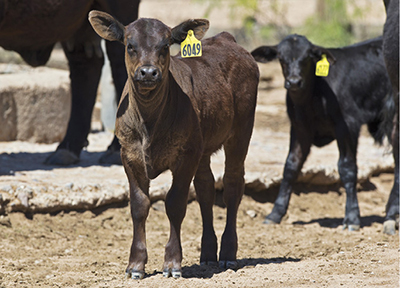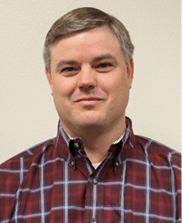Minimizing Weaning Stress on Calves
Guide B-221
Revised by Craig Gifford, Shiann Burns, and Marcy Ward
College of Agricultural, Consumer and Environmental Sciences, New Mexico State University
Authors: Respectively, Extension Beef Cattle Specialist, M.S. student, and Extension Livestock Specialist, Department of Extension Animal Sciences and Natural Resources, New Mexico State University. (Print Friendly PDF)
Weaning is one of the most stressful events in a calf’s life. Two primary stressors affect calves at weaning: social separation from their mothers and moving to a new environment where they must develop new feeding and watering skills and habituate to new surroundings. Management practices that minimize stress by making this transition less abrupt can improve calf health and weight gain. Facilities, labor, and feed resources should be considered when deciding which weaning protocol is most likely to minimize stress on calves while still preparing them for the next stage of production.

Social Transition
Prior to weaning, calves rely on their mothers as a source of food and social direction. At weaning, calves must transition into a new social structure within a group of their peers. That transition can be a major source of stress.
California researchers (Price et al., 2003) conducted a three-year study that compared behavior and post-weaning performance of calves that were 1) not weaned, 2) fenceline weaned, 3) abruptly weaned on pasture, 4) abruptly weaned in a drylot without being preconditioned to hay, or 5) abruptly weaned in a drylot after being preconditioned to hay. Calves in the fenceline-weaned treatment were allowed nose-to-nose contact with their dams for seven days, but were prevented from nursing by a separating fence. Results of the study indicated that, aside from vocalization, fenceline-weaned calves exhibited similar behavior to non-weaned control calves, and the fenceline-weaned calves spent more time eating than did calves weaned according to other methods (Table 1). Seven days after weaning, all calves in the study were managed together. Fenceline-weaned calves gained at least 50% more weight during the first two weeks after weaning than calves weaned according to the other methods, and retained the weight advantage through at least 10 weeks post-weaning.
|
Table 1. Average Percentage of Observations in Which Calves Exhibited Various Behaviors on Days 1 Through 3 and Average Cumulative Weight Gain at 2 and 10 Weeks Post Weaning1 |
|||||
|
Variable |
Pasture Control |
Pasture Weaned |
Drylot Weaned |
||
|
Not weaned |
Fenceline contact |
No contact |
Preconditioned to hay |
Not preconditioned |
|
|
Eating (%) |
41a |
37a |
24bc |
29b |
22c |
|
Walking (%) |
9a |
10ab |
28c |
10ab |
15b |
|
Lying down (%) |
23a |
23a |
16b |
22a |
21ab |
|
Vocalizations/hr |
0.1a |
216.7b |
434.6c |
371.2bc |
518.2c |
|
Gain after |
44a |
47a |
30b |
23b |
20b |
|
Gain after |
143a |
110b |
91c |
79c |
82c |
|
abcMeans with different superscripts within rows differ P<0.05. 1Price et al., 2003. |
|||||
In the Southwest, fenceline weaning is not practical on all ranches. However, some ranches have employed this low-stress weaning approach successfully. In 2006 and 2007, beef calves at the NMSU Corona Range and Livestock Research Center (CRLRC) were fenceline weaned for seven days. Other than the challenges associated with keeping cows and calves separated by marginal fencing, the NMSU fenceline weaning experience was positive. During both years, calves gained weight during the seven-day fenceline weaning period (Table 2), and outward signs of stress were minimal.
|
Table 2. Performance of Fenceline-weaned Calves at the NMSU Corona Range and Livestock Research Center |
|||
|
Year |
Weaning weight (lb) |
Seven-day |
Difference |
|
2006 |
468 |
484 |
16 |
|
2007 |
520 |
524 |
4 |
Fenceline contact between calves and their dams for four to seven days after weaning can lessen stress and minimize post-weaning performance decline. However, some evidence suggests that there are minimal differences between calves that have been abruptly separated and calves that are fenceline weaned. It is speculated that the calf’s ability to see its mother leads to a strong desire to suckle, resulting in stressful behavior responses like vocalization and pacing. Being able to view the mother can act as a stimulant that encourages these types of behavior, which may prolong the stress response. Other work has indicated that there was no significant difference in total body weight gain between fenceline weaning and abrupt separation. However, relative to New Mexico beef production, these results should be interpreted cautiously. In New Mexico, often cows and calves are gathered from large pastures and are separated into large pastures, which gives the cows and calves more of an opportunity to separate. It is likely that the fenceline-weaned behavior is different in a large pasture situation versus a small experimental pasture environment, which essentially forces cows and calves to remain in relatively close proximity. Indeed, fenceline weaning has been successful and is traditionally used the CRLRC. Work from Dr. Eric Scholljegerdes’ laboratory (unpublished) at the CRLRC demonstrated that calves weaned in a large pasture (3,956 acres) and fitted with GPS tracking technology traveled farther from the fence than calves weaned in a small pasture (287 acres). Most studies that have found fenceline weaning increases stress have weaned in pastures smaller than 15 acres. Thus, if calves are weaned in small pastures, abrupt separation could be a good option. However, the benefits of fenceline weaning could be realized in situations where calves are weaned in large pastures.
Environmental Transition
Whether fenceline weaned or weaned by traditional methods, most calves are eventually transitioned from pasture forage to the textures, consistencies, and flavors of grain-based rations, and are adapted to feeding from a bunk and drinking from troughs. At the same time, calves must habituate to the sounds and sights of tractors, feeders, and humans. In addition to the nutritional challenges of dietary change, the new environment can cause a great deal of stress to calves.
The two key elements of environmental transition are acclimatizing calves to a new water source and training them to eat from a feed bunk. When introduced to a new environment, newly weaned calves tend to spend a significant proportion of their time walking the perimeter of the pen or pasture, exploring its limits and searching for their dams. When calves are weaned into a small trap or drylot, managers can capitalize on this tendency by placing feed and water troughs along the fence to decrease unnecessary energy use by perimeter walking. If calves are weaned into a large pasture, it is recommended that, where it is practical, water and feed likewise be placed along a perimeter fence to increase the likelihood of calves finding feed and water within the first few hours in the new pasture. Transportation, particularly in New Mexico, can be another added source of stress, and care should be taken to not overcrowd calves in the trailer while moving to new pastures.
Summary
Weaning is a physically and psychologically stressful time in a calf’s life. Although it is impossible to completely avoid calf stress at weaning, producers can minimize weaning stress on the calf. When developing a low-stress weaning program, producers are encouraged to consider the following practices.
Tips to Minimize Stress from Weaning
Provide calves access to the weaning area (pen, trap, or pasture) a few weeks prior to weaning so calves do not undergo the stress of environment change at weaning. During separation at weaning, move the cows to a new location, but do not move the calves. Allow fenceline contact between calf and dam for four to seven days following weaning. Fences should be sturdy and allow nose-to-nose contact while preventing nursing. However, if fenceline contact is not practical, move cows far enough away that they cannot hear the calves vocalizing.
If weaning in a drylot or corral, place feed bunks, hay, and water troughs along the fence to minimize perimeter walking and increase encounters with feed and water. Placing large water troughs inside the pen and letting water troughs overflow slightly may attract calves to the water and help calves that are accustomed to drinking from live water sources adjust to troughs and to the sounds that occur when the float is activated.
Prevent unnecessary stress by castrating, dehorning, or branding calves prior to weaning. These practices should be completed at least three weeks before weaning and preferably prior to three months of age since the tissues are less developed and less vascularized. It also beneficial to vaccinate calves in advance of weaning to optimize antibody responses to the high-stress time of weaning. Increased levels of antibodies will provide protection against illness during the time of stress.
References
Arthington, J.D., S.D. Eicher, W.E. Kunkle, and F.G. Martin. 2003. Effect of transportation and commingling on the acute-phase protein response, growth, and feed intake of newly weaned beef calves. Journal of Animal Science, 81, 1120–1125.
Campistol, C., H.G. Kattesh, J.C. Waller, E.L. Rawls, J.D. Arthington, J.A. Carroll, G.M. Pighetti, and A.M. Saxton. 2016. Effects of pre-weaning feed supplementation and total versus fenceline weaning on the physiology and performance of beef steers. International Journal of Livestock Production, 7, 48–54.
Duff, G.C., and M.L. Galyean. 2007. Board-invited review: Recent advances in management of highly stressed, newly received feedlot cattle. Journal of Animal Science, 85, 823–840.
Enríquez, D., M.J. Hötzel, and R. Ungerfeld. 2011. Minimizing the stress of weaning of beef calves: a review. Acta Veterinaria Scandinavica, 53, 28. doi: 10.1186/1751-0147-53-28.
Enríquez, D.H., R. Ungerfeld, G. Quintans, A.L. Guidoni, and M.J. Hötzel. 2010. The effects of alternative weaning methods on behavior in beef calves. Livestock Science, 128, 20–27.
Price, E.O., J.E. Harris, R.E. Borgwardt, M.L. Sween, and J.M. Connor. 2003. Fenceline contact of beef calves with their dams at weaning reduces the negative effects of separation on behavior and growth rate. Journal of Animal Science, 81, 116–121.
Solano, J., A, Orihuela, C.S. Galina, and V. Aguirre. 2007. A note on behavioral responses to brief cow-calf separation and reunion in cattle (Bos indicus). Journal of Veterinary Behavior: Clinical Applications and Research, 2, 10–14.
For further reading
B-220: Value Added Calf Programs for New Mexico Livestock Producers
https://pubs.nmsu.edu/_b/B220/
B-223: Calf Vaccination Guidelines
https://pubs.nmsu.edu/_b/B223/
CR-648: Using Anti-Suckling Devices to Wean Beef Calves
http://aces.nmsu.edu/pubs/_circulars/CR648/

Craig Gifford is the NMSU Extension Beef Cattle Specialist. He earned his Ph.D. in animal physiology from the University of Idaho. His Extension work provides current research-based information to New Mexico beef producers to enhance profitability and ranch sustainability. In collaboration with county agents, he also organizes the ACES High Certified Calf Programs to promote Beef Quality Assurance practices and add value to New Mexico calves.
To find more resources for your business, home, or family, visit the College of Agricultural, Consumer and Environmental Sciences on the World Wide Web at pubs.nmsu.edu
Contents of publications may be freely reproduced for educational purposes. All other rights reserved. For permission to use publications for other purposes, contact pubs@nmsu.edu or the authors listed on the publication.
New Mexico State University is an equal opportunity/affirmative action employer and educator. NMSU and the U.S. Department of Agriculture cooperating.
Revised May 2018 Las Cruces, NM


